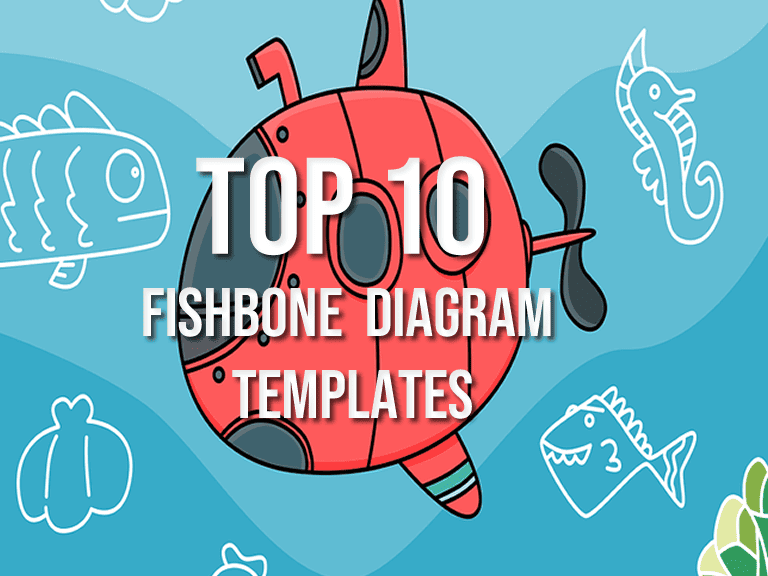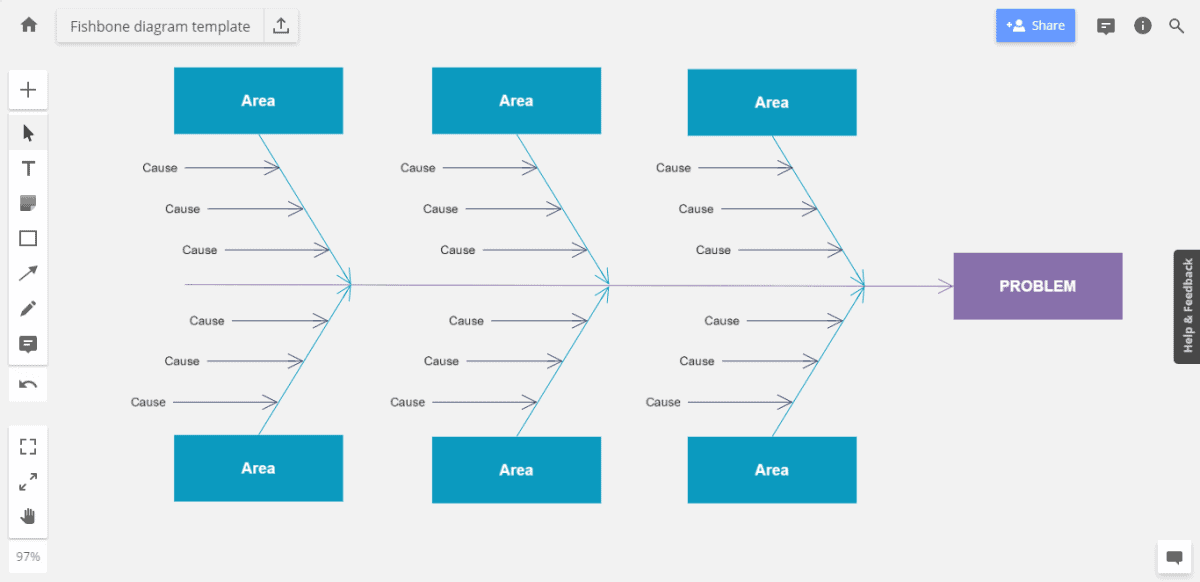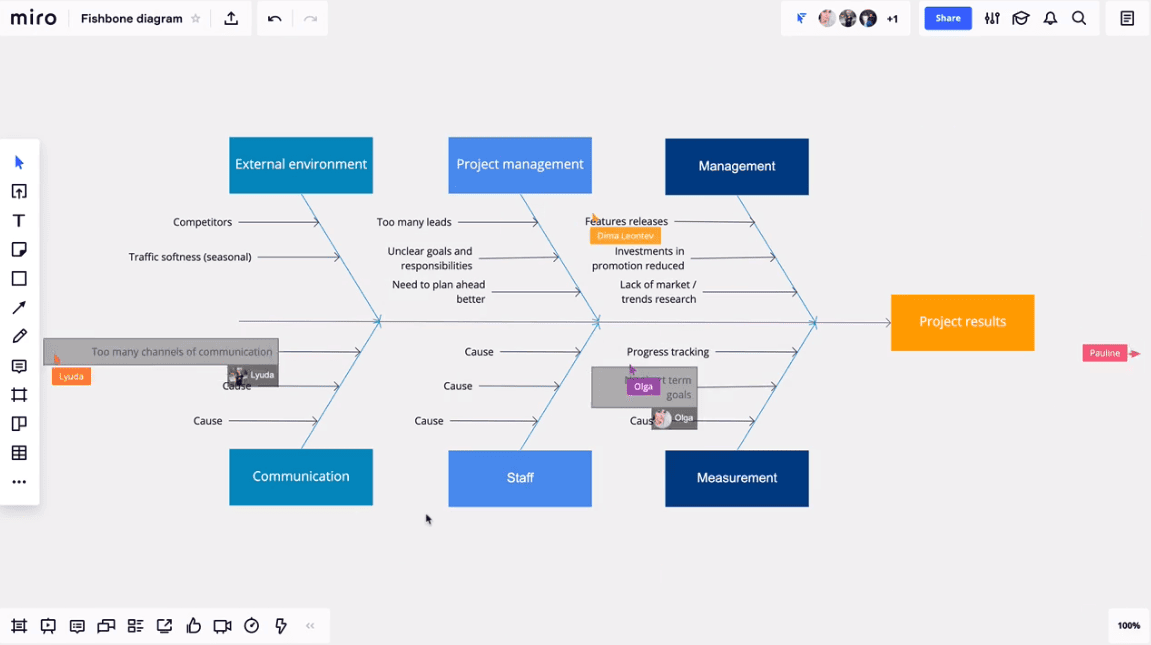
Virtual brainstorming is hard. It relies on people working together in sync. The team needs to be able to contribute and collaborate at the same time.
The fishbone diagram is a cause-and-effect brainstorming method. It is also known as the Ishikawa diagram (named after its inventor, Japanese quality control expert Kaoru Ishikawa). Combined with the five whys, it is easily one of the most effective tools for identifying cause and effect. It helps people quickly identify the root cause and stop guessing.
Other Names for Fishbone Diagram:
- Root Cause Analysis
- Cause and Effect Diagram
- Cause & Effect Mindmap
- Ishikawa diagram
What do you do after the fishbone diagram? The 5 Whys
You have started by creating as many branches as you see fit, all of which could be categories of the possible problem. The next step is to use the five whys to ask. The five whys help the team think of new causes. Then, you ask why this is causing the problem, and as you keep asking why, you create links on the branch. It should typically conclude after five whys.
If you are having issues with team motivation, you should check out our article on creating an Agile Team Charter with templates and examples.
Top 10 Best Free Fishbone Diagrams
Creating a fishbone diagram template isn’t rocket science. It’s more about using a tool that you are familiar with or that your organization is already using. I have listed a mix of paid and free tools.
- 10 Fishbone Diagram Templates in Word, Excel, & ClickUp: If you’re looking for an effective way to start your next cause analysis brainstorming session, check out our list of the 10 best templates for fishbone diagrams in ClickUp, Word, and Excel.
- 25 Great Fishbone Diagram Templates & Examples [Word, Excel, PPT]: Fishbone diagrams are used in root cause analysis to identify problems in product development or quality management.
- 8 Best Free Fishbone Diagram Templates & Examples for Analysis: If you’re looking to create a fishbone diagram, also known as an Ishikawa diagram or cause-and-effect diagram, but don’t want to start from scratch, we’ve got you covered.
- Fishbone Diagram Examples & Templates: Fishbone diagrams can be used as a tool to help a team visualize a complex problem and generate ideas for solutions.
- Fishbone Diagram Templates from Venngage: Easily demonstrate cause-and-effect with an attractive fishbone diagram
- 10 Free Fishbone Analysis Templates and How to Make One Within Minutes: Read this article to find a curated selection of 10 versatile templates that can assist you in conducting thorough and structured problem-solving sessions.
- Free Fishbone Diagram Templates and Step-by-Step Tutorials: Here are some fishbone diagram examples that you can use for free.
- 10 Free Fishbone Diagram Makers for Collaborative Problem Solving: Discover the fusion of tradition and modernity in problem-solving through fishbone diagram makers. This article explores their role in efficient, collaborative root cause analysis, showcasing real-time features and industry impact.
- Fishbone Diagram Templates ( Cause and Effect / Ishikawa Templates): Fishbone (aka Cause and Effect/Ishikawa) diagrams are great for analyzing processes and identifying defects.
- Fishbone Diagram for Excel, Google Sheets: Identify a problem’s root causes efficiently with a fishbone diagram. This visualization template categorizes potential causes, making it a valuable resource for root cause analysis.
Cause & Effect Mindmap for Remote Software Teams
The fishbone diagram can be considered a cause-and-effect mindmap, as it groups possible problem areas. It then helps teams easily visualize where all the possible causes could lead to the problem. To break down and get further causes, use the 5 whys approach with the fishbone diagram.

Create a problem statement as the fish head.
What is the problem? How does the problem occur? When does the problem happen?
Set broad categories or areas do potential causes fall into (max 10)
Possible categories for software products: Users, Software, Marketing, Integrations, Database
List out all of the individual causes for each category or area as the bones of the diagram
Use 5 Whys to dig deeper and uncover new potential causes systematically.
How do you make a fishbone diagram virtually?
Virtual brainstorming is hard. It relies on people working together in sync. You don’t have a whiteboard, as you would typically have to have people openly put up posters and feel like they can actively contribute. Using Google Hangouts or Zoom meetings is good, but it can be challenging for a facilitator to squeeze ideas out of people. We previously discussed how you can use icebreakers for virtual meetings to get people engaged, but what is the next step to continue engagement?
You can create fishbones with PowerPoint and share your screen looking for inputs, but it’s just one person driving the conversation and lacks the engagement you would get in real life.
How do you get virtual teams to engage in brainstorming?
The solution is to use virtual whiteboard tools such as Miro. The diagram below shows the people interacting. One of my favorite features is seeing people’s names as they interact so you can discuss them in the Zoom meeting while the person is making the changes.
This works mainly when you write out effects using the 5 why method mentioned above.

Virtual Fishbone Tutorial
Other Quality Checking Tools like The Fishbone Diagram
The fishbone diagram is one of the Seven Basic Tools of Quality. I would first check if the fishbone diagram weren’t precisely what I was looking for to help identify issues. Different circumstances require different tools.
- Stratification (Divide and Conquer)
- Histogram.
- Check Sheet (Tally Sheet)
- Cause-and-effect diagram (“fishbone” or Ishikawa diagram)
- Pareto chart (80/20 Rule)
- Scatter diagram (Shewhart Chart)
- Control chart
Shane Drumm, holding certifications in PMP®, PMI-ACP®, CSM, and LPM, is the author behind numerous articles featured here. Hailing from County Cork, Ireland, his expertise lies in implementing Agile methodologies with geographically dispersed teams for software development projects. In his leisure, he dedicates time to web development and Ironman triathlon training. Find out more about Shane on shanedrumm.com and please reach out and connect with Shane on LinkedIn.